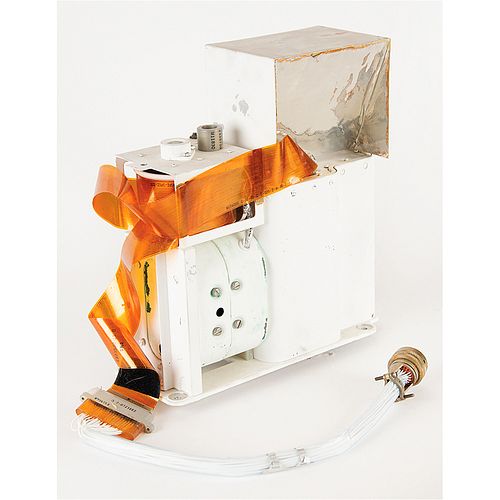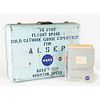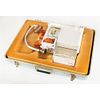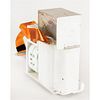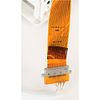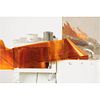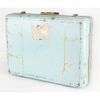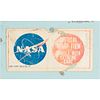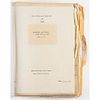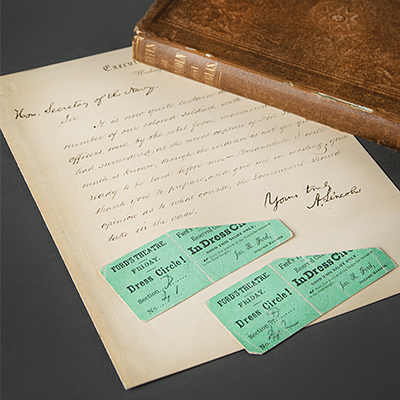Apollo 13 ALSEP Cold Cathode Gauge Experiment Flight Spare
Two ways to bid:
- Leave a max absentee bid and the platform will bid on your behalf up to your maximum bid during the live auction.
- Bid live during the auction and your bids will be submitted real-time to the auctioneer.
Bid Increments
| Price | Bid Increment |
|---|---|
| $0 | $5 |
| $50 | $10 |
| $200 | $25 |
| $500 | $50 |
About Auction
Sep 23, 2023
RR Auction support@rrauction.com
- Lot Description
Flight-ready backup of the Apollo 13 Cold Cathode Gauge Experiment (CCGE), designed for use on the lunar surface as part of the Apollo Lunar Surface Experiments Package (ALSEP). The CCGE was essentially a stand-alone version of the Cold Cathode Ion Gauge (CCIG), which was included in the ALSEP on Apollo 12, 14, and 15. Apollo 13 was the only mission to carry the experiment in this form factor, and represents one of the great 'what-ifs' of the Apollo program—the CCGE could not be deployed, as the lunar landing had to be aborted after the dramatic failure of the Apollo 13 spacecraft.
In an official manual prepared by NASA, 'ALSEP Handbook for the Apollo 13 Flight Crew,' the experiment's objective is defined: 'The objective of the cold cathode gauge experiment (CCGE) is to measure both the density and temperature of the lunar atmosphere and any variations it may have with time or solar activity. This data will provide information in the following areas: a. What is the pressure of the lunar ambient atmosphere? b. What is the rate of decay of contaminants left in the landing area by the astronauts and the LM?'
The unit measures 12″ x 13″ x 5″ and is labeled on the bottom of the baseplate: "Cold Cathode Gauge Experiment, P/N SEB391014280-204, S/N 1005." The CCIG and electronics assemblies are supported by a structural housing covered in a white thermal coating, the top plate of which serves as a heat sink. In addition, a sunshield is used with a reflector to shade the thermal plate from direct sunlight. A bullseye bubble is mounted on top of the structural housing to allow the astronaut to level the CCGE within 5° of level during deployment. Next to the level is the handling tool socket. A red arrow is painted on top of the experiment, which must be aligned east or west. The unit retains its ribbon cable and connector tether, which would allow it to be plugged into the ALSEP central station for data collection, processing, and transmission.
The experiment is housed in its heavy padded transport suitcase, measuring 25″ x 19″ x 7.5″, stenciled on the side: "Flight Spare, Cold Cathode Gauge Experiment for ALSEP." Additionally includes a thick bracket-bound "Acceptance Data Package" for the experiment, describing it as "Flight Unit No. Spare, S/N 1005," containing extensive documentation of the unit's assembly, testing, and quality control inspections.
In a NASA photograph taken during a practice moonwalk near the Kennedy Space Center's Flight Crew Training Building on February 3, 1970, Apollo 13 Commander James Lovell is seen working with an example of the ALSEP, with the CCGE deployed in the distant background. Unfortunately, this training proved futile—neither Lovell nor the CCGE would ever make it to the lunar surface. As the well-documented flight spare for a unique experiment carried on the Apollo program's most harrowing mission, this is a fantastic piece of NASA and space science history. - Shipping Info
-
Bidder is liable for shipping and handling and providing accurate information as to shipping or delivery locations and arranging for such. RR Auction is unable to combine purchases from other auctions or affiliates into one package for shipping purposes. Lots won will be shipped in a commercially reasonable time after payment in good funds for the merchandise and the shipping fees are received or credit extended, except when third-party shipment occurs. Bidder agrees that service and handling charges related to shipping items which are not pre-paid may be charged to a credit card on file with RR Auction. Successful international Bidders shall provide written shipping instructions, including specified Customs declarations, to RR Auction for any lots to be delivered outside of the United States. NOTE: Declaration value shall be the item’(s) hammer price and RR Auction shall use the correct harmonized code for the lot. Domestic Bidders on lots designated for third-party shipment must designate the common carrier, accept risk of loss, and prepay shipping costs.
-
- Buyer's Premium



 EUR
EUR CAD
CAD AUD
AUD GBP
GBP MXN
MXN HKD
HKD CNY
CNY MYR
MYR SEK
SEK SGD
SGD CHF
CHF THB
THB